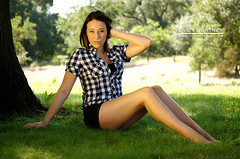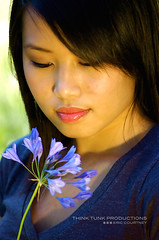
For this particular shoot, I contacted a pinup model to give Little Red Riding Hood more of an edgier look and feel. As well as some sex appeal, I must admit. Sacramento model, Linda Del Sol of the Vicious Betty's Pinup Dolls was available and willing to take on the role. I have worked with Linda before at a few live events, but until this shoot, I never got the opportunity to work with her 1-on-1. It was a good experience, but I wish we could have started earlier in the day.
For a shoot like this, I insisted on using evening magic light (twilight hours, for those of you who don't already know what Magic light is) because I had a few ideas that I wanted to work with. Some ideas required sunlight, some required partial darkness. I scheduled the shoot just days after the Daylight Savings Time switch-back for a 3:00pm start, which would give me a few hours workable light. Unfortunately...

Time would fly by faster than I anticipated; It's amazing how fast that big ball of fire in the sky falls when you're trying to create visual excellence. I did scout the locations the day before the shoot, but I don't feel I planned as effectively as I could have. I say that because even though I planned the shoot in segments around the locations as I was scouting, I found myself improvising much more than I would have liked during the actual shoot. I think the recent time change had a little bit to do with it. So the message here, I guess, is to try and plan a little for the "unexpected" during your preparations. I plan to blog about location scouting and preparations very soon.
Wardrobe was a no-brainer for this shoot. I chose an experienced pinup model because I knew she would be able to provide the bulk of the wardrobe for an edgy-sexy fairytale parody. The only other items I needed to get my hands on were a cape and a basket of goodies... And an axe of course because my plans had a dark element involved. Yes I am grinning as I write this.
I enlisted the help of a local fashion designer, Naomi May Designs, to create a cape for me that would work along with the wardrobe Linda was planning to wear. As for the props, it only took a little rummaging around the house to find a basket and axe. I should also mention that the great thing about hunting down props is that you will find other things that inspire ideas for future shoots. Keep a creative mind-set when prop hunting. It will pay off!
Linda did a great job for this scenario shoot. I like to call Photo Shoot Themes "scenario shoots." Scenario shoots, or a Theme Photo Shoot if you insist, is a lot different when it comes to directing your models. Instead of a model bringing an arsenal of high fashion poses and looks, you want her and/or him to be able to provide you with facial expressions and body language relative to the scenario they are creating. A model with acting experience is probably more often than not, and ideal fit for a shoot of this nature. I think it is important to let a model know before you hire her that what you expect of her is completely clear. That way everyone on both sides of the glass knows what to expect.
As you can see from the pictures displayed in this post, I got a few shots I am pretty happy with. If you would like to see a few more from the Little Red Riding Hood Shoot with Miss Linda Del Sol, check out my Sacramento Photography website. If you want to go straight to Linda's gallery, surf to the Little Red Riding Hood Gallery. I hope you enjoy it, and I look forward to any feedback you may provide.
Sacramento Photographer
Eric Courtney
If you like this article, please link to it.
Recent Articles:
Sacramento Photographer gets Artsy with Artistic Photographs
Photo Coloring - Coloring black and white photos effectively
Shooting Outdoors and Beating the Summer Heat
MUAH Hair and Makeup for Models
More Creative Photography Please...
Test Shooting
5 Easy Tips to Improve Portraits of Children
Camera Shy Subjects - The Art of Dealing with Photo Portrait Nightmares
Post Processing for Portrait Photography






